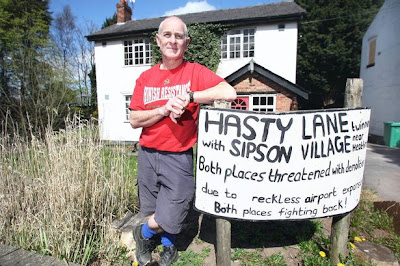P-AIRPORT LINK_ITV2000_Vimeo from Granada Reports on Vimeo.
Responding to today's announcement that a Chinese construction firm will be involved in the Airport City scheme, Robbie Gillett from Stop Expansion at Manchester Airport commented:
"Today's announcement is about pouring money into businesses that are reliant on aviation expanding from Manchester Airport, which depends on burning more and more fossil fuels pushing us closer towards a dangerous climate scenario. We should look beyond today's headline figures to ask: What sort of economy do we want to build? One that relies on a carbon-intensive business model where we fly goods and services back and forth across the globe? Or one where we create new jobs in a green industries, in sustainable transport and renewable energy to power a re-localised economy?
-------------------------------------------------------------------------------------------------------
Below's text from the Manchester Evening News - 13th October 2013
A Chinese construction company was today confirmed as part of the group that will develop an £800m business park next to Manchester Airport.
The Beijing Construction Engineering Group is involved in the joint-venture that will bring the Airport City scheme to reality over the next 12 years.
It is teaming-up with Manchester Airports Group, the Greater Manchester Pension Fund and UK construction firm Carillion to invest in the project, which aims to create up to 16,000 jobs.
Over the coming years, they will build a series of office blocks, logistics hubs, hotels and warehouses that will be filled by global companies lured to the region.
Property develop Argent, which is behind the One St Peter's Square scheme in Manchester city centre and led the revamp of London's Kings Cross station, has been appointed development manager.
The deal was announced by chancellor George Osborne during a special visit to Beijing today. It also marks the Far East launch of the Manchester-China Forum, which aims to boost trade links between the two locations. And it is hoped securing Chinese investment into the region will go a long way towards encouraging airlines to launch a direct service between Manchester and the Far East.
“The inclusion of BCEG is significant because as a Group, we have been keen to forge greater links with the Far East and this gives us an opportunity to strengthen vital business links with China.
“With GMPF on board, Greater Manchester is investing in the future of the north west and Carillion bring sector-leading experience in project finance, delivery and sustainability, both in the UK and internationally.
“In Argent, we have the one of the most renowned developers in its field and by working together as a partnership, we are well positioned to deliver the UK’s first Airport City.”
The joint-venture sees MAG take a 50 per cent stake, BCEG a 20 per cent stake, Carillion a 20 per cent stake and the GMPF a 10 per cent stake.
The J-V partners will then look to build offices, warehouses, hotels and manufacturing plants for specific tenants and then sell those sites on for profit once they are up-and-running.
Airport City sits at the hear of Greater Manchester's Enterprise Zone, which means companies choosing to locate there can benefit from business rate reductions and other perks.





